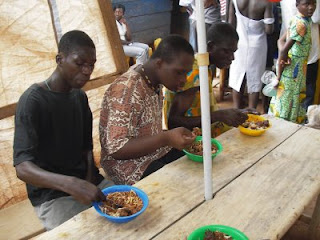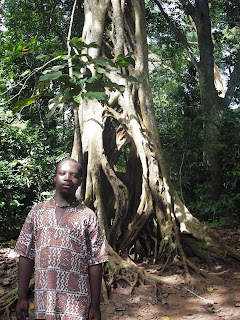I met Otis over 4 years ago when I was working on the refugee camp. He had polio as a kid and was on the camp alone. At one point, he had been sleeping on a table in the market. Before I arrived on the camp, Patrick (who I’d known since the time I was living in Cote d’Ivoire, and who I was fortunate to be able to visit last year at his new home in Norway) had noticed Otis and invited Otis to come train as a tailor and sleep in the workshop. By the time I arrived, Otis was well into his tailor training, and doing well. After a year, Patrick and his family got resettled to Norway, and Otis was completing his training. But Otis has a vision and some good plans – and he wanted to go on with his training to also learn embroidering – or “designing”, as it’s referred to here. I was getting some help from Liliane Fonds for my work with some of the disabled people, and they agreed to help Otis with his embroidery training.
Finally, Otis was ready to open his own shop, and he wanted to return the assistance he’d received by assisting other people with disabilities to learn how to sew and embroider. The UNHCR was possibly going to be assisting him in this effort (but their help never quite came through in the way that he hoped and needed). Through my friends and family who made donations through me, and also with Liliane Fonds, we were able to help him to meet some of his goals – he was able to get an embroidery machine, a few extra sewing machines and a generator (the electricity was always going off on the camp). So, Otis had a school in his workshop where he was training people with different disabilities while at the same time trying to run his own tailoring business. And, twice a week he was also giving sewing classes at the school for the deaf – and he was trying to learn a little sign language.
me and Otis, my last day of work on the camp, last year

For the past few months, there’s been a lot of increased pressure and encouragement for Liberians to return to Liberia. And for some people, this was easier than for others. The UNHCR allowed a limited amount of baggage to be carried back – and some people have been living on the camp for 18 years now, so they’re certain to have established some kind of life and acquired possessions – furniture, tv, stereo – and in Otis’ case, equipment for running a business. Again, a friend who’d help Otis in the past and had even met him while visiting a couple of years ago was able to help out a lot. David had just lost his job, but had money set aside that he asked if I needed for anyone. As often is the case – God works in wonderful ways and the timing was perfect. Otis timed things well; he shipped his tailoring equipment to Liberia, where he had someone he trusted to receive it and keep it safe for him until he returned a week or so later. He also submitted a proposal to the UNHCR for assistance in establishing a training school, similar to what he had on the camp, back in Liberia. And he registered with the UN for his return trip – meaning they would pay for his return trip to Liberia. All was fine. Until UN told Otis he needed to wait until they reviewed his proposal and he found himself stranded on the camp with his means of living secure with his friend in Liberia. We were able to help him out, again with a few nicely timed donations, while he waited . . . and waited . . . and then waited some more. Until – after about 2 months – he was told by the UN that they no longer provide that assistance here and he should return to Liberia to submit the proposal there. So – finally he was heading back – and all was ready to go – and the plane they (the other Liberians scheduled to return at the same time) were to be on had mechanical problems and he ended up being delayed another couple of weeks.
But now he’s back – and he called me almost as soon as he landed. He hit the ground running – checked out his stuff, which was all fine, then went to the part of Liberia (Ganta) where he wants to set up his school to see what the situation is like and what's available along the lines of buildings or land or whatever is needed. When he returned to Monrovia he submitted his proposal to the Liberia Refugees Repatriation and Reintegration Commission and to the United Nation Development Program, from where he was later told that he will have to wait until next year before he will receive any response from them.
Anyway – he’s always impressed me. He has his dreams, his plans, his goals – and they’re goals that will help him and will build up his country. And not just build up his country by introducing new skills (embroidery is not very common in Liberia), but will build up a group of people (the ones with disabilities) who are often left behind. Not only does he have these dreams and plans (lots of people have dreams and plans), but he has followed through with them – he researches them, he makes contacts, he keeps the contacts, etc. I like the guy, and we’re friends, but at the same time I know part of why he called me almost as soon as he landed is to keep that connection – not just keep a friendship.
I recently received another email from Otis. He plans to start working as soon as possible, not waiting for a response, which may or may not be favorable, from those organizations. So he has gone around to find out the options. He found a place he could rent for $50 per month. He was able to borrow money for 3 months, and he's trusting that somehow, before the time is up and he gets sacked from the place, the $600 for a full year's rent will come in so he can pay off the landlord, and also pay off his debt.
As has so often been the situation during my time in Africa, especially my time on the refugee camp, so much moves forward based upon trust and faith in God. Sometimes this works as hoped and believed. Sometimes, our faith is tested, and what we hoped and believed and wanted to happen isn't how it works out. And the faith in God's plan not necessarily being our plan - that God's vision is greater than ours - is truly tested. I'll let you know how this works out for Otis.












































